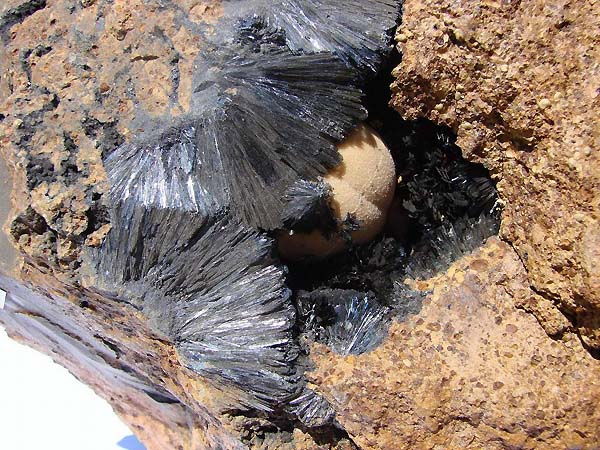Stone, minerals and semiprecious of the world stone
Oxide and hydrooxide: Limonite -->rus
 Diagnostic cart.
Diagnostic cart.
On a photo. Crystals of calamine, hemimorphite in the accumulation of swamp ore from Mexico
Crystal structure changeable
Hardness on the Mohs scale 5-5,5
Specific unit weight mass about 4
Cleavage non-existent
Fracture, break padman or earthy
Colors brown-yellow, gold, black
Colors in powder triturate brown-yellow, gold
Glance (glitter, glare) earthy to porcelain
Presents mix of different oxides of iron, which a goethite and lepidocrocite (mineral of area of oxidization of iron-stones; dyeing pigment of ferrous ochres) is present among. Limonite is never observed as crystals; more frequent than all be found as rather yellow earthy the masses, easily collapsing, or rounded brown accumulations and light crusts. A common brown, black, or yellow amorphous secondary mineral that consists of hydrated ferric oxides and is a source of iron. Formula: FeO(OH)*nH2O.
Limonite (brown ironstone). Mineral mixture, arising up at decomposition of iron-bearing ferruginous minerals; in it makes main mass usually thinly crystal or needle-shaped Goethite (ferrous aciculite) is hydroxide of iron. Glance (glitter, glare) glassy ("brown glass head"), dim. Opaque. Colors yellow, gold to darkly-brown. A line is yellow to by a borax. Fracture, break padman, rough or earthy. Cleavage non-existent.
Forms of selection can be earthy, fibred, oolitic-like, dense, wandering ("brown glass head"). The varieties of лимонитовых of ores are bob ores, pratal, or bog, yellow earthy ochres ores. Deposit minefield mine field occurrence subsoil: Lotaringiya is Luxemburg (minette ores), Lower Saxony and Bavaria (Germany), England, CIS (Kerch, Ural, Karelia and other).
Diagnostic indication.
Hardness on the Mohs scale is determined hardly, as mineral crumbles easily. It can vary depending on components, entering in the complement of aggregate. Usually material scratches a knife. Fuse melt, at heating in a glass kimberlite tube selects plenty of water. A behavior is in acids. Dissolves in HCl.
Chemical composition (chemistry, compound). Oxide of iron (Fe2О3) 86-89%, water (N2O) 10-14%. Form of crystalline, excretions. Tonkokristallicheskie, fibred, columnar, basaltiform aggregates, earthy, continuous the masses, kidney-shaped reniform concretion is very widespread, stalactitic-like and spherical forms (brown "glass head"), oolitic and bob ores. Cleavage. Good.
Origin provenance genesis.
Limonite is the second formation, formed in the area of oxidization of deposits of iron ("gossans"), In a tropical and subtropical climate appears at dissolution of carbonate and silicate rocks (lateritic-like). Can have an organic origin also, when hydroxide of iron settle in bog terms (favourite environment for the action of bacteria).
Deposit minefield mine field occurrence subsoil.
Most important from point of industrial development lateritic deposits on Cuba, in Venezuela, Brazil, Angola, Congo, Canada and India. The widely known deposits of Elzase and Lotaringiya have sedimentary genesis.
Use, practical application, deployment.
Limonite in modern black metallurgy used not too widely, as contains tracks of phosphorus. An earthy variety (yellow ochre) is used in the production of paints and as forming molding material.

Barit, vivianite (kertschenite) is in swamp ore. Reed-Breaker, Kerch, Crimea, Ukraine.

Goethite (Limonite). Orlovskiyк, Khalilovskiy, Ural, Russia. A photo: © A.A. Evseev.
